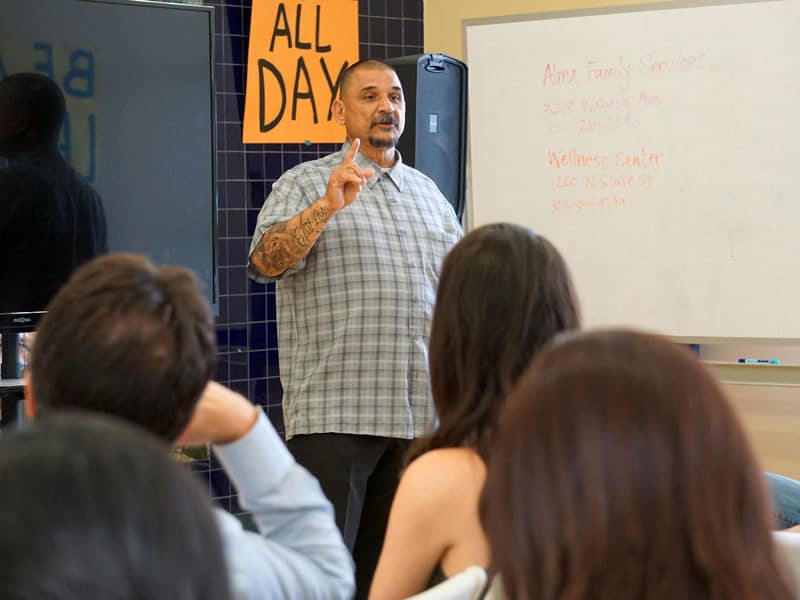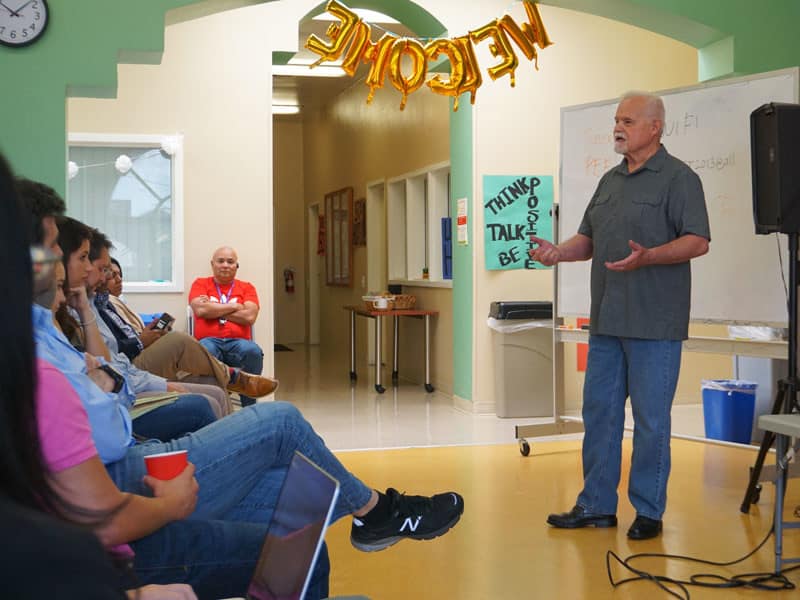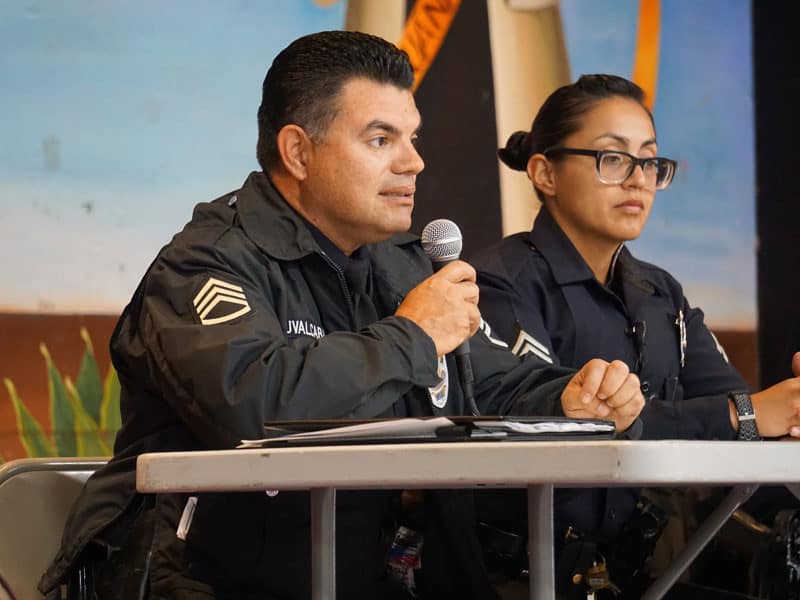Lessons from LA inform global violence prevention efforts
Study tour brings practitioners from Latin America and the Caribbean to learn from Los AngelesMay 28, 2019
By Evelyn Rupert
LOS ANGELES – Mike Areyan stands up in front of the crowd and announces that during the work week, he normally wears long sleeves. But today, he says, he put on a short-sleeved shirt so that his audience could see his story, inked in tattoos that cover both of his arms.
Areyan is a former gang member who began working directly with gangs to halt the cycle of violence that he was once trapped in himself; he is now a Violence Intervention Coordinator at nonprofit Southern California Crossroads.
Areyan and other intervention workers shared their personal and professional experiences with a group of more than 60 violence prevention practitioners from Latin America and the Caribbean as part of a Los Angeles study tour organized by the U.S. Agency for International Development and its El Salvador Crime and Violence Prevention Project, which is implemented by Creative Associates International. Countries represented included El Salvador, Honduras, Colombia, Nicaragua and Guatemala.

The three-day tour followed the annual Gang Prevention and Intervention Conference, which took place in Long Beach, Calif. May 13-14. Through panel discussions, presentations and site visits, the study tour group gained insights into how Los Angeles is reducing violence through four parallel pillars: prevention, intervention, reinsertion and law enforcement.
Enrique Roig, Director of Creative’s Citizen Security Practice Area, says that the study tour serves to share program ideas with countries in Latin America and the Caribbean that are struggling with high levels of crime and violence and to foster cross-country partnerships.
“We’re building a worldwide movement of violence prevention practitioners that allows for sharing of evidence-informed and effective violence reduction programs and strengthening our efforts by learning from one another,” he said. “We are connected by geography, demographics, culture and shared history, and we should continuously be looking for ways to collaborate on violence prevention.”
Preventing and halting violence
The study tour’s first stop was at Alma Family Services, where staff talked about the resources they offer to engage communities, parents and youth and prevent young people from becoming involved in gangs or violence through the Los Angeles Gang Reduction and Youth Development office’s (GRYD) model.
GRYD’s family systems approach to diagnosing youth risk and reducing risk factors through family counseling has been adapted by Creative for application in El Salvador, Honduras, the Caribbean and Tunisia. The unique approach builds upon the strength of families and uses evidence to inform programming.

Ninoksa Duarte, programs, training and research specialist for the USAID-funded Proponte Más violence prevention project in Honduras, said the study tour gave her fresh insight into her own program through learning about what others are doing.
“Getting to know the GRYD project a little bit better was extremely helpful and allowed me to understand where the work that we are doing in Proponte Más was born,” she said. “One idea that I consider extremely important is how we join forces to begin to change the focus from being on youth identity to youth actions.”
To stop cycles of violence, intervention workers like Areyan work in the streets to offer alternatives to active members, cool tensions and provide support for families.
On call around the clock, these intervention workers, also known as community outreach workers, respond when tensions between groups are at their highest, including in the immediate aftermath of a violent incident. Some intervention workers visit hospitals to speak with victims and their families and to try to prevent a retaliatory attack from taking place.
Supporting reentry
In his closing keynote address at the Gang Prevention and Intervention Conference, Father Greg Boyle, founder of Homeboy Industries remarked: “There is no us and them, just us.”
The study tour group had a chance to see how Boyle has built that idea into bustling operation that provides gang members, those exiting prison and others affected by gang violence with job training, employment, therapy, classes, tattoo removal and more. Former rivals work side by side, welcoming people from behind the front desk, screen printing T-shirts for sale at the gift shop and baking muffins at Homegirl Bakery.
The group also spent an afternoon at Amity Foundation, a therapeutic and teaching community where men exiting prison, some after decades, can live and receive services aimed at healing while they readjust and refocus on life outside.
Study tour participant Natalia Velasco Castrillón, Children and Youth Director at the Colombian Family Welfare Institute, said she saw at Amity and Homeboy the importance of focusing on rehabilitation and mental health the moment that someone exits prison.
“They have so many needs, and if we can accompany them in that transition to freedom, it will be more possible for them to stay away from reoffending,” she said. “We need to understand the pain in the hearts and souls of communities, individuals and families so that going forward, they understand that they can make different decisions.”
Law enforcement’s role in prevention
The relationship between police and residents of high-violence neighborhoods is often fraught with deeply rooted fear and mistrust on both sides.
But the Los Angeles Police Department officers involved in the Community Safety Partnership program are working to rebuild that relationship through local outreach and showing that the role of police doesn’t have to be limited to enforcement.

“We understand that we cannot fix a problem by putting people in jail,” said Sgt. Nathan Ruvalcaba. “We have to work with them.”
Ruvalcaba and other officers involved discussed the Community Safety Partnership initiative at a Boys and Girls Club in the Ramona Gardens housing project, where they engage young people in sports and fun activities like the Summer Night Lights program to reshape the perception of police and restore trust.
Bringing LA lessons back home
Study tour participants acknowledged that there will be many challenges in trying to replicate the work that’s been done in L.A. to reduce violence over the past several decades in their own contexts.
However, building cross-country connections, sharing ideas and experiences and seeing an organization like Homeboy Industries thriving gives a new perspective on what is possible.
Jaime Zablah, inspired by what he saw at Homeboy on a previous visit, established the Factoría Ciudadana (Citizen Factory) in El Salvador to provide reentry support with assistance from the Crime and Violence Prevention Project.
The project is also partnering with Salvadoran NGOs to adapt and apply the street- and hospital-based violence intervention work being done in Los Angeles to El Salvador. While small, these initiatives are evidence that lessons learned in the U.S. can help propel the field of violence prevention in other countries, and vice versa.
“I hope that participants will be inspired by what they see in L.A. and that they will take program ideas back to their countries with renewed vigor to invest in violence prevention efforts,” said Roig of Creative. “More importantly, we hope participants come away with the awareness that no one program will solve the problem; we have to bring together prevention, intervention, exit strategies for formers, and law enforcement in a coordinated fashion.”

